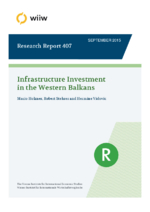Infrastructure Investment in the Western Balkans
Mario Holzner, Robert Stehrer and Hermine Vidovic
wiiw Research Report No. 407, September 2015
43 pages including 12 Tables and 28 Figures
Summary
Although a certain amount of catching-up in the Western Balkans has been recorded in the construction of transport infrastructure in recent years, the railway density remains low and the motorway density is even lower. Also, the deficiency in energy infrastructure is substantial. The current initiative of the ‘Core Network and Priority Projects’ in the context of the ‘Berlin Process’ should secure growth and employment in the region over the short and medium term and contribute to a substantial improvement of competitiveness of the Western Balkans in the long term. It is shown in the analysis that a comprehensive transport infrastructure investment package of EUR 7.7 billion over a period of 15 years could lead to an additional growth spurt of up to one percentage point per annum for the six Western Balkan countries. Some 200,000 new jobs could be created in the region.
Reference to wiiw databases: wiiw Annual Database, wiiw FDI Database
Keywords: infrastructure, public investment, economic development, simulation model, Berlin Process, Western Balkans
JEL classification: E27, H54, O18
Countries covered: Albania, Bosnia and Herzegovina, Kosovo, North Macedonia, Montenegro, Serbia
Research Areas: Macroeconomic Analysis and Policy, Labour, Migration and Income Distribution, International Trade, Competitiveness and FDI
